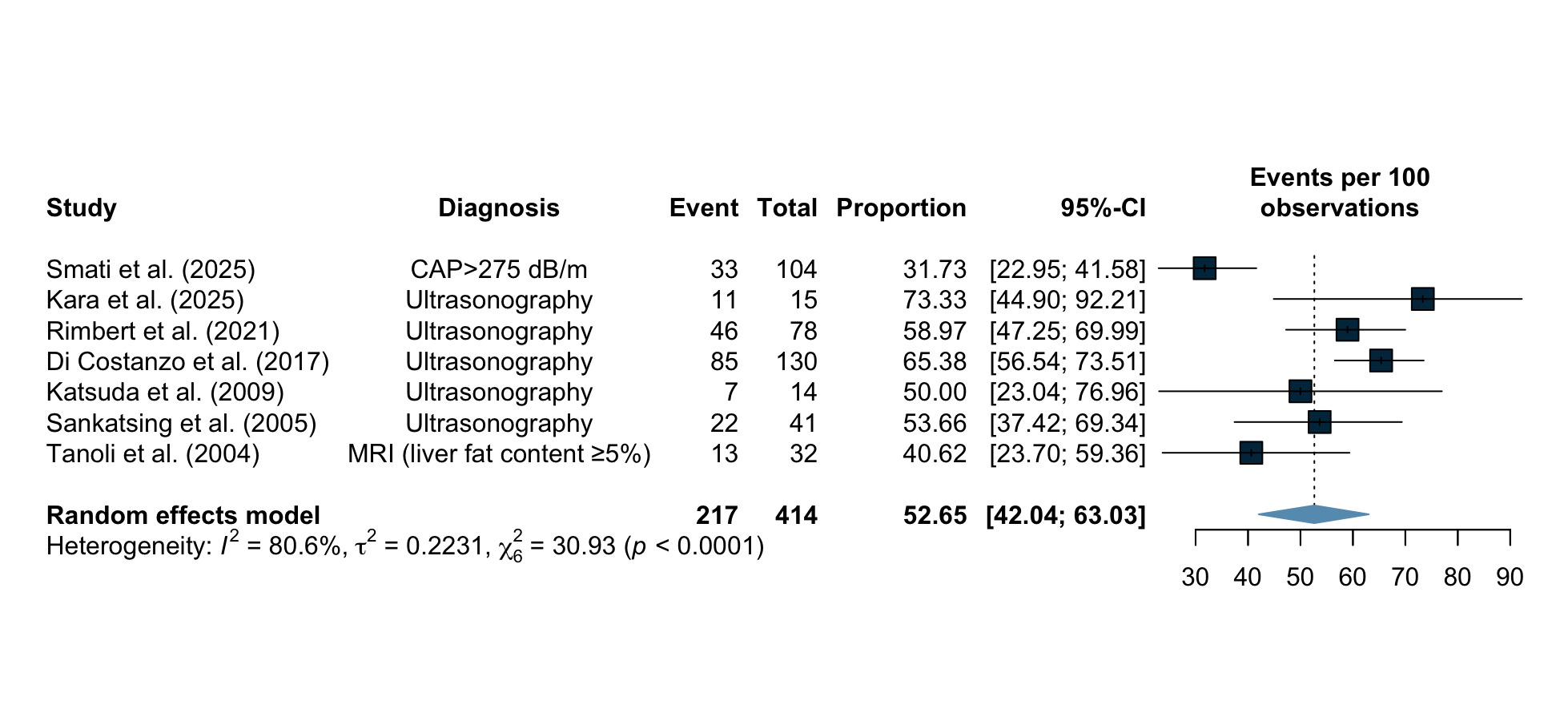Sunday Poster Session
Category: Liver
P1657 - Primary Hypobetalipoproteinemia as a Specific Etiology of Steatotic Liver Disease: Systematic Review and Meta-Analysis
Sunday, October 26, 2025
3:30 PM - 7:00 PM PDT
Location: Exhibit Hall

Ivanna Diaz Alcantara, MD (she/her/hers)
SUNY Downstate Health Sciences University
Brooklyn, NY
Presenting Author(s)
Ivanna Diaz Alcantara, MD1, Matheus Souza, MS2, Saeed Ahmad, MBBS, MD3, Kariana Martinez, MD1, Ali Syeda, MD1
1SUNY Downstate Health Sciences University, Brooklyn, NY; 2Federal University of Rio de Janeiro, Rio de Janeiro, Rio de Janeiro, Brazil; 3Beth Israel Deaconess Medical Center, Harvard Medical School, Brookline, MA
Introduction: Primary hypobetalipoproteinemia (HBL) is a rare genetic condition marked by persistently low levels of low-density lipoprotein cholesterol. Due to impaired secretion of very-low-density lipoprotein, individuals with HBL are at risk for developing hepatic steatosis. Under the recently adopted steatotic liver disease (SLD) nomenclature, HBL is recognized as a specific etiology. However, the actual burden of SLD in this population remains uncertain. To address this gap, we conducted a systematic review and meta-analysis to estimate the prevalence of SLD in individuals with primary HBL.
Methods: We searched PubMed and Cochrane databases from inception through May 31, 2025, for observational studies reporting the prevalence of SLD assessed by non-invasive imaging in ≥10 individuals with primary HBL. Meta-analysis was conducted using a generalized linear mixed model with Clopper-Pearson intervals to estimate pooled proportions (PROSPERO ID: CRD420251064877).
Results: Of the 154 records screened, 7 studies comprising 414 individuals were eligible. Five of these studies assessed liver steatosis using ultrasound. The pooled prevalence of SLD in primary HBL was 52.65% (95% CI 42.04–63.03, I²=80.6%). The diagnostic method significantly influenced SLD prevalence (p< 0.0001), with pooled prevalences rates of 61.51% (95% CI 55.66–67.05), 40.62% (95% CI 23.70–59.36), and 31.73% (95% CI 22.95–41.58) for ultrasound, transient elastography, and magnetic resonance imaging, respectively. No significant differences were observed across world regions (p=0.65). Specifically in familial HBL, the pooled prevalence of SLD was 57.35% (95% CI 47.32–66.82).
Discussion: This is the first meta-analysis to quantify the prevalence of SLD in individuals with primary HBL, revealing that approximately half of these individuals develop SLD. These data confirm the high burden of SLD in this population and support the consideration of HBL as a clinically relevant, specific etiology within the SLD spectrum, particularly for patients without traditional cardio-metabolic risk factors. Management algorithms that incorporate routine liver imaging may be necessary for this population. Future studies should explore the natural history, risk of fibrosis, and treatment options tailored to this underrecognized subgroup.

Figure: Figure 1- Forest plot reporting prevalence of steatotic liver disease in patients with primary hypobetalipoproteinemia
Disclosures:
Ivanna Diaz Alcantara indicated no relevant financial relationships.
Matheus Souza indicated no relevant financial relationships.
Saeed Ahmad indicated no relevant financial relationships.
Kariana Martinez indicated no relevant financial relationships.
Ali Syeda indicated no relevant financial relationships.
Ivanna Diaz Alcantara, MD1, Matheus Souza, MS2, Saeed Ahmad, MBBS, MD3, Kariana Martinez, MD1, Ali Syeda, MD1. P1657 - Primary Hypobetalipoproteinemia as a Specific Etiology of Steatotic Liver Disease: Systematic Review and Meta-Analysis, ACG 2025 Annual Scientific Meeting Abstracts. Phoenix, AZ: American College of Gastroenterology.
1SUNY Downstate Health Sciences University, Brooklyn, NY; 2Federal University of Rio de Janeiro, Rio de Janeiro, Rio de Janeiro, Brazil; 3Beth Israel Deaconess Medical Center, Harvard Medical School, Brookline, MA
Introduction: Primary hypobetalipoproteinemia (HBL) is a rare genetic condition marked by persistently low levels of low-density lipoprotein cholesterol. Due to impaired secretion of very-low-density lipoprotein, individuals with HBL are at risk for developing hepatic steatosis. Under the recently adopted steatotic liver disease (SLD) nomenclature, HBL is recognized as a specific etiology. However, the actual burden of SLD in this population remains uncertain. To address this gap, we conducted a systematic review and meta-analysis to estimate the prevalence of SLD in individuals with primary HBL.
Methods: We searched PubMed and Cochrane databases from inception through May 31, 2025, for observational studies reporting the prevalence of SLD assessed by non-invasive imaging in ≥10 individuals with primary HBL. Meta-analysis was conducted using a generalized linear mixed model with Clopper-Pearson intervals to estimate pooled proportions (PROSPERO ID: CRD420251064877).
Results: Of the 154 records screened, 7 studies comprising 414 individuals were eligible. Five of these studies assessed liver steatosis using ultrasound. The pooled prevalence of SLD in primary HBL was 52.65% (95% CI 42.04–63.03, I²=80.6%). The diagnostic method significantly influenced SLD prevalence (p< 0.0001), with pooled prevalences rates of 61.51% (95% CI 55.66–67.05), 40.62% (95% CI 23.70–59.36), and 31.73% (95% CI 22.95–41.58) for ultrasound, transient elastography, and magnetic resonance imaging, respectively. No significant differences were observed across world regions (p=0.65). Specifically in familial HBL, the pooled prevalence of SLD was 57.35% (95% CI 47.32–66.82).
Discussion: This is the first meta-analysis to quantify the prevalence of SLD in individuals with primary HBL, revealing that approximately half of these individuals develop SLD. These data confirm the high burden of SLD in this population and support the consideration of HBL as a clinically relevant, specific etiology within the SLD spectrum, particularly for patients without traditional cardio-metabolic risk factors. Management algorithms that incorporate routine liver imaging may be necessary for this population. Future studies should explore the natural history, risk of fibrosis, and treatment options tailored to this underrecognized subgroup.

Figure: Figure 1- Forest plot reporting prevalence of steatotic liver disease in patients with primary hypobetalipoproteinemia
Disclosures:
Ivanna Diaz Alcantara indicated no relevant financial relationships.
Matheus Souza indicated no relevant financial relationships.
Saeed Ahmad indicated no relevant financial relationships.
Kariana Martinez indicated no relevant financial relationships.
Ali Syeda indicated no relevant financial relationships.
Ivanna Diaz Alcantara, MD1, Matheus Souza, MS2, Saeed Ahmad, MBBS, MD3, Kariana Martinez, MD1, Ali Syeda, MD1. P1657 - Primary Hypobetalipoproteinemia as a Specific Etiology of Steatotic Liver Disease: Systematic Review and Meta-Analysis, ACG 2025 Annual Scientific Meeting Abstracts. Phoenix, AZ: American College of Gastroenterology.
